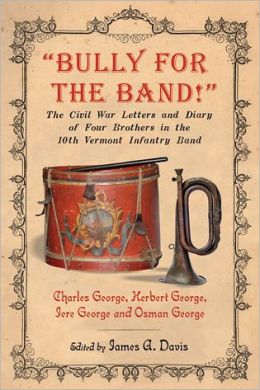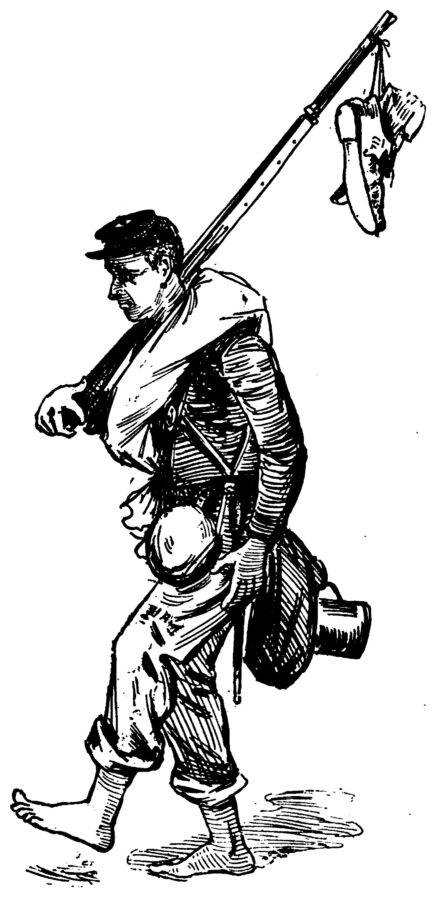“Bully for the Band!”: The Civil War Letters and Diary of Four Brothers in the 10th Vermont Infantry Band edited by James A. Davis. McFarland, 2012. Paper, ISBN: 0786466863. $49.95.
 As the title of his book suggests, James A. Davis, Professor of Musicology and Chair of the Music History Area at the State University of New York, Fredonia, has transcribed and compiled the wartime letters of four brothers who served in the 10th Vermont Infantry Regiment as band members. These letters tell the story of four Civil War musicians—Charles, Herbert, Jeremiah, and Osman George—who, like many of their contemporaries, left their homes in small-town Vermont to embark on a wartime journey that would forever change their lives, as well as those of their families. Davis has arranged the brothers’ letters in chronological order, beginning with their enlistment in summer 1862 and concluding with their homecoming in Burlington, Vermont, in July 1865. In between, the George brothers, whose regiment joined the Army of the Potomac at Harpers Ferry in June 1863, saw action in Meade’s Mine Run Campaign, Grant’s Overland Campaign, Sheridan’s Shenandoah Valley Campaign, and the Union siege of Petersburg, among other operations. Present at both Appomattox Court House and Danville, Virginia, the George brothers served in the Union army until fighting in the Eastern Theater concluded.
As the title of his book suggests, James A. Davis, Professor of Musicology and Chair of the Music History Area at the State University of New York, Fredonia, has transcribed and compiled the wartime letters of four brothers who served in the 10th Vermont Infantry Regiment as band members. These letters tell the story of four Civil War musicians—Charles, Herbert, Jeremiah, and Osman George—who, like many of their contemporaries, left their homes in small-town Vermont to embark on a wartime journey that would forever change their lives, as well as those of their families. Davis has arranged the brothers’ letters in chronological order, beginning with their enlistment in summer 1862 and concluding with their homecoming in Burlington, Vermont, in July 1865. In between, the George brothers, whose regiment joined the Army of the Potomac at Harpers Ferry in June 1863, saw action in Meade’s Mine Run Campaign, Grant’s Overland Campaign, Sheridan’s Shenandoah Valley Campaign, and the Union siege of Petersburg, among other operations. Present at both Appomattox Court House and Danville, Virginia, the George brothers served in the Union army until fighting in the Eastern Theater concluded.
In addition to the George brothers’ letters, Davis has consulted an impressive array of manuscript collections, unit histories, letters, memoirs, soldiers’ reminiscences, and secondary articles and monographs to place the Georges’ experiences within the broader context of Civil War musicians, the history of the 10th Vermont, and the day-to-day lives of Union soldiers in general. Davis tells this larger story by interspersing his own editorial commentary amongst the George brothers’ correspondence, usually inserting a few of his own paragraphs after every 2-3 letters. Indeed, Davis’ book is as much a unit history of the 10th Vermont as it is a collection of the four musicians’ correspondence.
In a fourteen-page introduction, Davis provides a brief overview of the role played by musicians in the Civil War—as field musicians (i.e., drum corps) who signaled the soldiers’ daily movements, and as band members who provided entertainment and lifted their cohorts’ morale. Though typically not required to engage in combat, Civil War musicians sometimes saw front-line duty as stretcher-bearers and ammunition carriers. Additionally, they helped move artillery pieces, build fortifications, and served on picket duty. In the heat of the fighting, field musicians were also “called upon to play combat calls, such as ‘Fix Bayonet,’ ‘Quick Time,’ and ‘Cease Firing,’” activities that could lead to injury or death (4). As Davis points out, disease “made no distinction between musician and combat soldiers” (8). Indeed, Osman George suffered from dysentery and ultimately died in a Washington hospital in December 1863. According to Davis, six of the thirty-one men who served as musicians in the 10th Vermont did not survive the war. Davis argues, and the George letters seem to verify, that the brothers were quite typical of many provincial New England farm boys who left their homes to enlist in Civil War armies: “All four brothers were fairly well educated, experienced in music, strong in their faith, and committed to their families,” much like their contemporaries (13). As the letters from their 1863-64 winter camp at Culpepper County, Virginia, indicate, the George brothers grew tired of camp life and were war-weary, though like many of the era’s soldiers, they remained eager for action.
Although Bully for the Band does not tread any new interpretative ground, it is a nice addition to the voluminous collection of published primary sources from the Civil War era. Because it highlights the experiences and perspectives of four musicians, it represents a unique contribution to our understanding of a demographic that thus far has received marginal attention from scholars. As a Professor of Musicology and author of several articles on Civil War music, Davis seems ideally suited to bring us this perspective. Thanks to the addition of Davis’ commentaries, this book should be as accessible to laypeople as it is to professional academics. Readers seeking additional information about Civil War music and musicians would be wise to consult Christian McWhirter’s Battle Hymns: The Power and Popularity of Music in the Civil War, as well as Professor Davis’ articles in American Music and The Journal of Military History.
David Schieffler is a Doctoral Student in History at the University of Arkansas.
